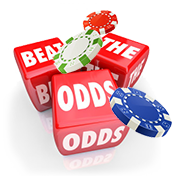Your Guide To Understanding Poker Odds Online

By Carl Bevin
Editor in Chief

Hollywood may paint a romantic picture of poker where a man knows his opponent's cards simply by looking at the way he handles his chips, but life isn't really like that.
Any aspiring player aiming to win big will quickly come unstuck if they don’t have a solid grasp of mathematics and odds.
In poker, there are three main forms of odds that new players will need to familiarise themselves with if they wish to succeed.
Here, we look at pot odds, implied odds and reverse implied odds and explain how properly understanding them will help you to make better decisions at the table.
Types of Poker Odds
Pot Odds
One of the most basic components of poker maths is the concept of pot odds. Working out pot odds is a matter of finding the ratio between the size of the current pot and the cost of a call. This can then help players select the best course of action to take.
Example: Let's assume you are holding pocket aces and face a bet on the river. The board is showing three hearts, making a flush a possibility.
There are currently 150 chips in the pot and your opponent bets 50, taking the total pot up to 200. It now costs you 50 chips to win 200 chips, meaning you are essentially risking one unit to win four.
What should you do facing this bet?
Well, getting 4-1 pot odds your hand only needs to be winning 20 percent of the time to break even. So, if you assume your aces are the best hand (unless your opponent has made a flush), you should call providing you think they are capable of bluffing more than 20 percent of the time.
As your opponent could also be betting many hands other than a flush here, such good pot odds make the call an easy one.
Implied Odds
Unlike pot odds which are based on fixed amounts, the concept of implied odds is a little trickier. Implied odds aim to estimate the value of betting that has not yet happened.
Using implied odds you can sometimes make a call with a draw when not being offered the correct pot ones. This can be done only if you can extract further bets later on from your opponent.
Example: Let's say you are facing a bet on the flop holding a flush draw. If the pot is currently 100 and your opponent is charging you 100 to see the turn, you are not getting the correct pot odds to call (you are calling 50 percent of the total pot on a draw that will only come in on the turn around 17.5 percent of the time).
However, if your opponent has more chips behind and you believe they will pay off further bets if you make your flush, you may be able to justify making a speculative call.
The problem with relying on implied odds is that they are purely theoretical. Just because your opponent has 1,000 chips behind doesn’t necessarily mean you will win all of them if you make your hand. For example, they may shut down as soon as the third flush card arrives and not put any further money into the pot.
Reverse Implied Odds
Reverse implied odds work in much the same way as implied odds. The difference here, however, is that they refer to when you are likely to lose further bets with a marginal hand that is unlikely to improve.
In situations like these, you tend to win the minimum when you’re ahead (because your opponent stops betting) and lose the maximum when you’re behind. That's not the situation you want to be in.
Example: While reverse implied odds may sound complicated, when put into real hand context, they’re actually pretty simple.
Let’s suppose you’ve called a raise with K-J in the big blind and the flop comes king-high. You check to your opponent and they bet. You are now in a reverse implied odds situation: if you call, your opponent is likely to continue betting hands that have you beat like K-Q and A-K, but will probably stop betting with anything worse. Therefore, you often lose more than you win.
Naturally, the problem here is that your hand is too good to fold to a single bet, so you are often obliged to call on the flop and re-evaluate on the turn.
As such, the only real way to avoid putting yourself in a reverse implied odds situation is to simply avoid playing weak Broadway hands like K-J when you are out of position. Change your strategy if you know that your opponent is capable of bluffing frequently.



